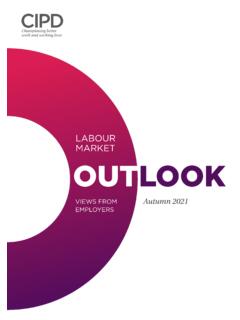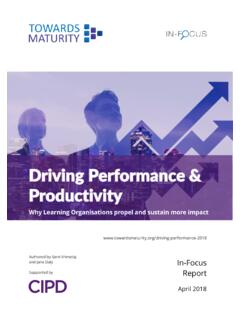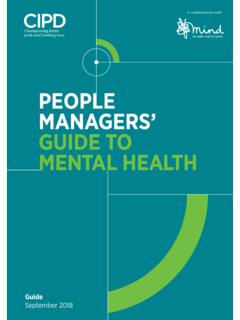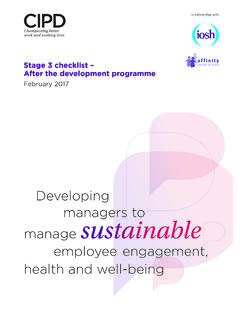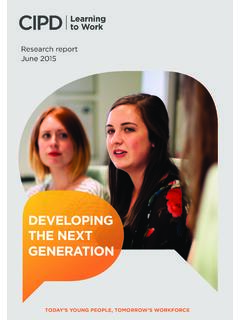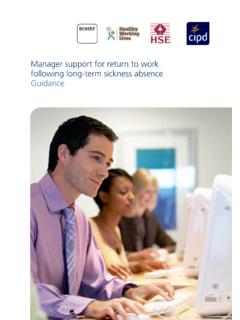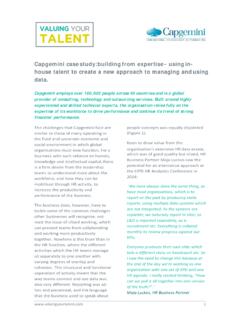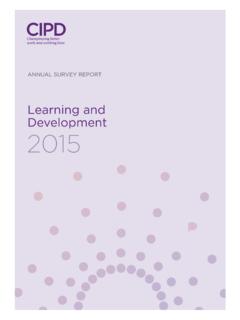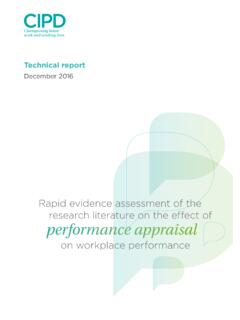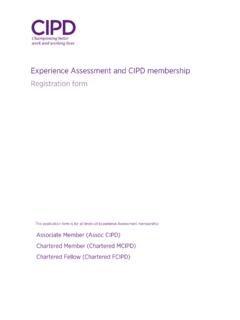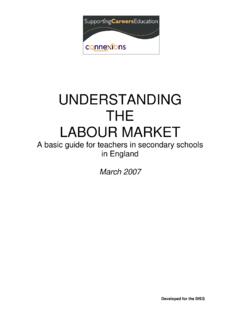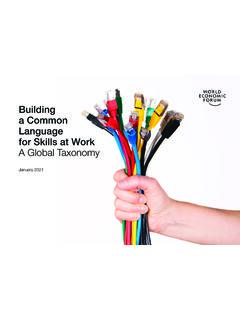Transcription of LABOUR MARKET OUTLOOK - cipd.co.uk
1 OUTLOOKVIEWS FROM EMPLOYERSLABOURMARKETS ummer 2021 The CIPD is the professional body for HR and people development. The registered charity champions better work and working lives and has been setting the benchmark for excellence in people and organisation development for more than 100 years. It has more than 150,000 members across the world, provides thought leadership through independent research on the world of work, and offers professional training and accreditation for those working in HR and learning and MARKET OUTLOOK Summer 2021 ReportLabour MARKET OUTLOOK Summer 2021 Contents 1 Foreword from the CIPD 22 Key points 3 3 Recruitment and redundancy OUTLOOK 4 4 Job vacancies 95 Pay OUTLOOK 10 6 Survey method 122 LABOUR MARKET OUTLOOK Summer 20211 Foreword from the CIPDThe quarterly CIPD LABOUR MARKET OUTLOOK aims to provide an early indication of future changes to the LABOUR MARKET around recruitment, redundancy and pay intentions. The findings are based on a survey of more than 2,000 was a time when we could gauge the extent of the economy s reopening by the furlough statistics.
2 At one point, almost 9 million people (about 28% of those employed) were on Employers could quickly adjust to changes in demand by bringing workers on or off furlough, and they did. We saw dramatic drops in the numbers furloughed with the easing of COVID-19-related restrictions and similarly sensational rises as restrictions were re-imposed. However, the latest surveying by the Office for National Statistics (ONS) shows that in late June 2021, approximately 5% of the workforce was on furlough, the lowest proportion since the Coronavirus Job Retention Scheme The ability to flex the workforce using furlough is gradually waning and, in response, recruitment is picking up. This report shows that employers are pulling out all the stops to get the workforce they need to meet demand. Having mostly exhausted the massive contingent workforce that existed on furlough, they are now opening recruitment as well as focusing on retention by reducing redundancies. Encouragingly the most popular response to hard-to-fill vacancies is to focus on upskilling existing staff.
3 It is worth reflecting on just how dire things seemed this time last year when many of the metrics in this report reached their lowest ebb. Economic forecasts made for grim reading, but with the relatively successful vaccine rollout and the roaring success of furlough in saving jobs and maintaining capacity in the economy, forecasts have been revised. Successive revisions to unemployment forecasts have seen the peak squashed down from a figure in similar territory to the post-financial crisis (a painful in the Office for Budget Responsibility s November 2020 forecasts)3 to a much more modest (Bank of England s May 2021 forecasts).4 The Bank of England is expecting the economy to be back to its pre-pandemic size by the end of this expectations of employers for the following three months as laid out in this report confirm these forecasts. Employers expect a swift summer reopening and return to normality. Anxiety about mass job losses has been replaced with the opposite fear for employers namely, an inability to recruit enough of the right staff.
4 The median employers expectation of basic pay settlements has held at the 2% level reached last quarter, after four consecutive quarters at 1%. Some sectors could see higher figures still if recruitment difficulties Boys, CIPD LABOUR MARKET Economist1 HMRC. (2021) Coronavirus Job Retention Scheme statistics: 1 July 2021. London: HM Revenue & ONS. (2021) Business insights and impact on the UK economy: 15 July 2021. London: Office for National OBR. (2020) Economic and fiscal OUTLOOK November 2020. London: Office for Budget Monetary Policy Committee. (2021) Monetary policy report: May 2021. London: Bank of from the CIPD3 LABOUR MARKET OUTLOOK Summer 2021 LABOUR MARKET OUTLOOK Summer 20212 Key points The net employment balance which measures the difference between employers expecting to increase staff levels in the next three months and those expecting to decrease staff levels has risen for the fourth consecutive quarter. At +32, it has reached its highest level since tracking began.
5 Recruitment is driving the balance upwards. The proportion of employers planning to recruit in the three months to September 2021 has risen again to 69%. The percentage of employers looking to make redundancies has settled around 13%. This forward-looking figure suggests that the end of furlough will be a relatively smooth transition with minimal job losses. 51% of employers in the hospitality/arts/entertainment industry report hard-to-fill vacancies compared with 39% for all employers. After dropping to 1% growth for four consecutive quarters during the pandemic, median basic pay settlements have held at the 2% pre-pandemic level reached last quarter. Key points+11 1 Autumn2020 8 Summer2020 Net employment score recoveryWinter2020/21+27+32 Spring2021 Summer2021 Recruitment continues to rise69%Winter2019/20 Spring2020 Summer2020 Autumn2020 Winter2020/21 Spring2021 Summer202116223330201213% of employers to make redundanciesHard-to-fill vacancies in hospitality51%Overall median basic pay settlements2%4 LABOUR MARKET OUTLOOK Summer 2021 Recruitment and redundancy outlook3 Recruitment and redundancy outlookThe net employment balance measures the difference between the proportion of employers that expect recruitment and redundancies to increase staff levels and those that expect to decrease staff levels in the second quarter of 2021.
6 With the onset of COVID-19 in 2020, the balance plunged into negative territory, but the recovery in employer confidence since has been dramatic (Figure 1). For the third consecutive quarter, the balance is positive. In fact, the balance grew from +27 in spring 2021 to +32 in summer 2021. The net employment balance is +33 in the private sector, +30 in the voluntary sector and +27 in the public sector (see Figure 1). 0 Private sectorVoluntary sectorTotalPublic sectorBase: summer 2021, all employers (total: n=2,042; private: n=1,473; public: n=352; voluntary: n=217)Figure 1: Net employment balanceSpring 2015 Summer 2015 Autumn 2015 Winter 2015/16 Spring 2016 Summer 2014 Autumn 2014 Spring 2014 Winter 2014/15 Summer 2016 Autumn 2016 Winter 2016/17 Spring 2017 Summer 2017 Autumn 2017 Winter 2017/18 Spring 2018 Summer 2018 Autumn 2018 Winter 2018/19 Winter 2020/21 Spring 2019 Summer 2019 Autumn 2019 Winter 2019/20 Spring 2020 Summer 2020 Autumn 2020 Spring 2021 Summer 202133323027 25 15 51525 Net employment balance535 The balance has been driven up by a higher proportion of employers looking to increase their staff levels (Figure 2).
7 This is mirrored in official statistics, with vacancies registering 10% above pre-pandemic levels in the latest Like our employment balance, vacancies are to an extent forward-looking due to lead times in recruitment. Meanwhile, official statistics are also showing that redundancies have settled back to pre-pandemic At previous stages of the pandemic, employers have been able to flex the workforce to meet demand by taking employees on and off furlough, resulting in dramatic changes to numbers furloughed in response to easing of restrictions. This is becoming more difficult to do as the proportion of the workforce on furlough decreases, meaning that active recruitment is having to work ONS. (2021) Vacancies and jobs in the UK: July 2021. London: Office for National ONS. (2021) Employment in the UK: July 2021. London: Office for National MARKET OUTLOOK Summer 2021 LABOUR MARKET OUTLOOK Summer 2021 Recruitment and redundancy outlookBase: summer 2021, all employers (n=2,042)405070809010060 Increase total sta levelMaintain total sta levelDecrease total sta levelDon t knowFigure 2: Composition of employment intentions in the quarter immediately before, and quarters since, the onset of COVID-19 (%)Decomposition of net employment balance (stacked bars)0102030 Winter 2019/20 Spring 2020 Summer 2020 Autumn 2020 Winter 2020/21 Spring 2021 Summer 2021102249195776950364046681550272544242 945521511533233 The net employment balance remains positive for all industries but is particularly high in healthcare (+58), hospitality/arts/entertainment (+48) and IT (+41) (Figure 3).
8 Figure 3: Net employment balance, by industry (%)584841403734302927272523211817 HealthcareInformation and communicationAdministrative and support serviceactivities and other service activitiesConstructionHotels, catering and restaurants/arts,entertainment and recreationVoluntaryBusiness services (for example consultancy, law, PR,marketing, scientific and technical services)Manufacturing and constructionFinance and insuranceTransport and storageEducationWholesale, retail and real estatePublic administration and other public sectorManufacturingBase: For breakdown of base sizes, see Table MARKET OUTLOOK Summer 2021 Recruitment and redundancy outlookRecruitment intentionsThe proportion of employers planning to recruit in the three months to September 2021 has risen again to 69% (Figure 4). Public sectorVoluntary sectorTotalPrivate sectorSpring2019 Summer2019 Autumn2019 Winter2019/20 Spring2020 Summer2020 Autumn2020 Winter2020/21 Spring2021 Summer202140305060708090 Base: summer 2021, all employers (total: n=2,042; private: n=1,473; public: n=352; voluntary: n=217)Figure 4: Recruitment intentions, by broad sector (%)83726965% of employers planning to recruit in the next three months20 The change in fortunes for some of the most heavily affected sectors is dramatic, with hospitality/arts/entertainment moving from 26% of employers looking to hire in summer 2020 to 72% looking to hire in 2021 (Figure 5).
9 Transport and storage is the industry with the second biggest range, from 33% of employers looking to recruit in summer 2020 to 65% in summer 2021. Both these industries have been heavily affected by the pandemic and immigration changes as a result of : For breakdown of base sizes, see Table 5: Recruitment intentions, by industry, summer quarters 2020 and 2021 (%)Wholesale, retail and real estateAdministrative and support serviceactivities and other service activitiesTransport and storageManufacturingEducationVoluntaryHo tels, catering and restaurants/arts,entertainment and recreationInformation and communicationFinance and insurance% of employers planning to recruit in the next three monthsConstructionBusiness services (for example consultancy, law,PR, marketing, scientific and technical services)2030405060708090100203040506070 8090100 HealthcarePublic administrationand other public sector7 LABOUR MARKET OUTLOOK Summer 2021 LABOUR MARKET OUTLOOK Summer 2021 Recruitment and redundancy outlookRedundanciesThe percentage of employers looking to make redundancies has settled around 13% in total and for both the public and private sectors (Figure 6).
10 This is in stark contrast to the total figure of 33% in summer : summer 2021, all employers (total: n=2,042; private: n=1,473; public: n=352; voluntary: n=217)1050152530403520 Public sectorVoluntary sectorTotalPrivate sectorSpring 2020 Spring 2021 Summer 2021% planning redundancies in the next three monthsSummer 2020 Autumn 2020 Winter 2020/21 Figure 6: Redundancy intentions, by broad sector (%)1513 Unsurprisingly it is hospitality/arts/entertainment with the lowest percentage of employers looking to make redundancies (7%), closely followed by transport and storage (8%) (Figure 7). Employers are not just looking to recruitment to ameliorate staffing difficulties. Workforce size depends on flows in and out, and so employers are also focusing on retention and cutting back on redundancies. While the range between summer 2020 and summer 2021 is large for most industries, figures in healthcare and the public sector have moved the least because their workforce needs have remained more consistent throughout the MARKET OUTLOOK Summer 2021 Recruitment and redundancy outlookBase: For breakdown of base sizes, see Table 7.
